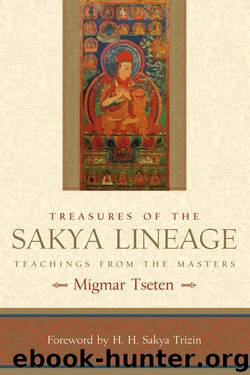Treasures of the Sakya Lineage: Teachings from the Masters (Paths of Liberation Series) by Migmar Tseten

Author:Migmar Tseten
Language: eng
Format: azw3
Publisher: Shambhala Publications
Published: 2011-07-29T03:00:00+00:00
Then when we are able to increase our level of meditation and have no fear of the meditation on emptiness, we have patience toward the meditation itself. It has become bearable and not something of which we are afraid any longer. This is known as patience.
When we are able to overcome any form of fear through our meditation on emptiness—meaning we overcome different types of conceptualization that arise to obstruct us from gaining this realization—then we get to the fourth stage, which is known as the highest, or most excellent, Dharma. However, our realization of emptiness is still not achieved at this stage. We have accomplished all the different types of worldly dharmas but not the transcendental Dharma of the state of realization of emptiness. Everything up to this stage has been accomplished.
According to the Hinayana (ordinary) teaching, anyone in this world of existence who is born as a man or woman with proper organs and anyone within the first six heavenly states of the realm of desire is able to gain the path of application. According to the Madhyamaka or Mahayana teaching, there are others who are also able to obtain this path.
It is said that only those who have gained one of the four states of dhyana, which is divided into six types of meditation found in the realm of form, can accomplish or dwell within the path of application. According to the Hinayana, we realize the nature of the four noble truths within this path. Each of the four noble truths has four aspects, such as the aspect of selflessness, resulting in sixteen aspects that are realized at this time.
According to certain Mahayana teachings, such as the Mind-Only school, during the first two parts of the path of application (that is during heat and foremost), there is a realization of nongrasping toward external objects, or of objective reality. At the time of patience and the highest Dharma, there is a state of nongrasping toward internal subjective reality.
Some teachers, such as Nagarjuna, said that when a person meditates while in the path of application, there is no separate arising of realization such as nongrasping of object and nongrasping of subject. Though the realization of emptiness is not complete, the wisdom arising from the meditation on emptiness increases through these four aspects of heat, foremost, patience, and highest Dharma. This actually produces a more stable understanding of the meditation of emptiness, though it is not completely realized.
Download
This site does not store any files on its server. We only index and link to content provided by other sites. Please contact the content providers to delete copyright contents if any and email us, we'll remove relevant links or contents immediately.
The Way of Zen by Alan W. Watts(6292)
Ego Is the Enemy by Ryan Holiday(4963)
The Art of Happiness by The Dalai Lama(3851)
The Book of Joy by Dalai Lama(3708)
Why Buddhism is True by Robert Wright(3291)
Spark Joy by Marie Kondo(3090)
Shift into Freedom by Loch Kelly(3032)
Happiness by Matthieu Ricard(2890)
A Monk's Guide to a Clean House and Mind by Shoukei Matsumoto(2787)
The Lost Art of Good Conversation by Sakyong Mipham(2444)
The Meaning of the Library by unknow(2393)
The Third Eye by T. Lobsang Rampa(2174)
The Unfettered Mind: Writings from a Zen Master to a Master Swordsman by Takuan Soho(2160)
Red Shambhala by Andrei Znamenski(2074)
Anthology by T J(2049)
The Diamond Cutter by Geshe Michael Roach(1957)
Thoughts Without A Thinker: Psychotherapy from a Buddhist Perspective by Epstein Mark(1900)
Advice Not Given by Mark Epstein(1767)
Twilight of Idols and Anti-Christ by Friedrich Nietzsche(1764)
